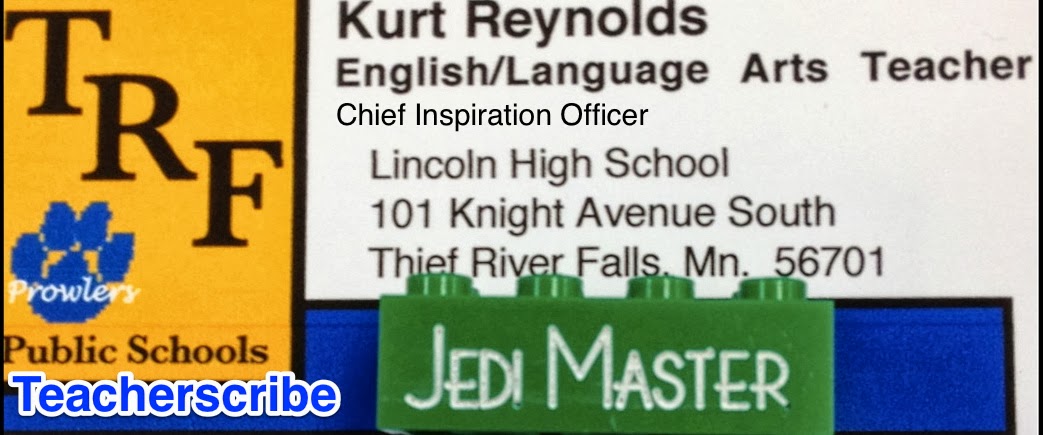In Lit & Lang 9R, we are finishing Mark Mathabane's Kaffir Boy. It is his autobiographical account of growing up in South Africa under the brutal apartheid system and finally escaping to American because of his outstanding grades and tennis ability.
We read chapters 46 and 47 aloud. Since these are freshmen, they are not ones to volunteer questions. So as we read the chapters, I paused and asked them for feedback. As it turned out, we had the best discussion of the year.
Now, my class is quite diverse, well diverse for NW MN. In a class of 15, I have three Hispanic students and two African American students. So reading a book about class warfare and racism is quite interesting.
Chapter 46 starts out with Mathabane meeting Adrew Zietsman, a white South African who has spent time in the United States. He informs Mathabane that in the U.S. there is no segregation (at least compared to the terrible conditions in South Africa).
This resulted in me asking them about why segregation no long exists in America. Soon we were talking about Martin Luther King Jr. and Jim Crowe and bus bombings and how if I showed them the pictures of southerners bombing buses coming down from the north for the freedom rides, they would never think that the picture was taken in America. Maybe in Iraq or Afghanistan but never in America.
This led us to talk about how tolerant our society is today. It is not taboo any longer for races to date and marry. I told them how generations ago, it was taboo for people of different religions or nationalities to marry. I recall how a friend told me how his grandmother, a Catholic, had married someone of a different faith, and his great-grandmother (her mother), never spoke to her husband after he refused to convert to Catholicism. Now that is in no way the standard reaction. Still it shows how far we've come in several generations when it comes tolerance and acceptance.
After a few more pages, Mathabane referenced the South African laws forbidding inter-marriage. This got us talking about genetics and skin color. Somehow we got on the topic of The Cosby Show. I related how big of a controversy it was that the Cosby kids seemed to be whiter than their parents and how many people got worked up over this. I recall reading an article stating that for the first time in TV history there are two very successful black lead characters (Bill was a doctor and Phylicia was a lawyer), yet their kids can't be full black, they have to come from bi-racial families. I loved the first few seasons of the show and didn't really notice anything about the skin color.
Soon students were sharing other stories and most everyone was engaged and taking part. Or at least listening in to the conversation.
Ch. 46 is also where Andre explains to Mathabane that while attending white schools, not only do the whites receive an elite education from the best teachers, but they are also educated (I mean brainwashed) to think that God has chosen them to rule over the blacks, who are a subservient race because of the Biblical figure of Ham.
This was news to me. I did tell them that I've read accounts of racists using Cain as a reason to think blacks were a tainted species. Supposedly, God marked Cain. Some interpret that mark as a darkening of his skin. Thus, that made anyone with dark skin an easy target for white supremacists.
I did tell them, though, that when I read the book Black Like Me, in which the author, a white man, has his skin blackened and then tours the south to see what racism is really like, the one place he consistently finds shelter and meals is from the southern Catholic churches.
Then this led us on a discussion of whether or not the Bible is to be taken literally. I shared my opinion, but let all voice theirs. We never judged or made fun of. We just shared and entertained a wide array of ideas and interpretations.
The chapter also focuses on Mathabane's tennis skills. This led us into talking about why blacks dominate at some sports (basketball being one) and why whites dominate at others (hockey being one). Then a student asked, "Why are African Americans better athletes?"
One of my African American students - to my surprise - totally disagreed. He thought whites and blacks are equal.
I shared with them what little knowledge I have on the topic and then asked my football players if they knew who holds the record for the fastest 40 time ever at the NFL combine, which happens to be just a month or two away. The record, as best as I could recall, was set by Deion Sanders in 1989 with a 4.21 40 yard dash. Then I asked them if they had ever heard of the receiver Don Beebe.
No one had.
I said that he ran the same time at the combine a few years later. And Don Beebe was white.
Again, students shared their views and chimed in when they wanted to get back to the book.
Finally, one of the students, Trevor, smiled and said, "I wish we could keep talking like this every day."
Alas, we have to meet standards and get them ready for the BST in reading.
But it was so much fun while it lasted. I think it's fair to say most of us learned more in that day of sharing and discussion than we have in three weeks of reading the book and focusing on reading and comprehension skills.

No comments:
Post a Comment